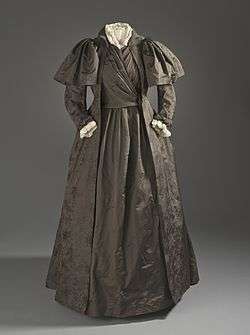Tea gown
A tea gown or tea-gown is a woman's dress for informal entertaining at home. These dresses, which became popular around the mid-19th century, are characterized by unstructured lines and light fabrics. Early tea gowns were a European development influenced by Asian clothing and historical approach from the 18th century which led to the renaissance time period of long and flowing sleeves.[1][2] Part of this European sense of fashion came from the Japanese kimono which was worn by Japanese women during a wedding or any formal ceremonies.[3]

Tea gowns were intended to be worn without a corset or assistance from the maid; however, elegance always came first.[4]
During the 19th century, it was not appropriate for women to be seen in public wearing a tea gown.[4] They were intended to be worn indoors with family and close friends during a dinner party.[4][5]
Although tea gowns were meant for midday wear, they could be worn into the evening.[5] Women started wearing tea gowns in the evening for dinner or certain events at home with close friends and family by 1900.[5] Tea gowns intended for day wear usually had high necks, while evening tea gowns had lower necks.[5]
Notes
- Takeda and Spilker (2010), p. 112
- Vic. "Downton Abbey Season 2: Teagowns and relaxation". Jane Austen's World. Retrieved February 5, 2012.
- Favors, LaTasha. "Japanese Kimono History". USA TODAY.
- "Terminology: What is a tea gown?". The Dreamstress. June 14, 2012.
- Post, Emily (1922). "Dress". Etiquette in society, in business, in politics and at home. Funk & Wagnalls Company.
References
| Wikimedia Commons has media related to Tea gowns. |
- Takeda, Sharon Sadako, and Kaye Durland Spilker, Fashioning Fashion: European Dress in Detail, 1700 - 1915, LACMA/Prestel USA (2010), ISBN 978-3-7913-5062-2
